Version 1.0 - Last Updated: 08 Jul 2025
Creating courses
Creating a full-time undergraduate course
This chapter tells you how to create a full-time undergraduate course.
It covers everything you'll need to know before you start adding these courses to CMS, including:
- eligibility
- academic year and course duration
- term dates and holidays
- fees
Eligibility
Students on a full-time undergraduate course will normally attend the university, college or other teaching location for at least 24 weeks of the year.
During that time, we expect them to undertake:
- periods of study
- tuition
- learning in the workplace
- a sandwich work placement that does not meet the sandwich year out criteria
These should amount to at least 21 hours per week on average.
For courses 2 years or more, full-time students will normally attend the university, college or other teaching location for at least 8 weeks in the final year.
Apprenticeship and graduate entry courses
Apprenticeship and graduate entry courses are generally not eligible for funding. You should therefore not add these to CMS.
However, there are some undergraduate courses where a degree in a relevant subject is a prerequisite to entry. These courses are designated for student support and qualify for funding:
- graduate entry – veterinary medicine
- graduate entry – medicine
- graduate entry – dentistry
- graduate entry – social work (Northern Ireland only)
Graduate Diploma for Northern Irish students
Northern Ireland-domiciled students are not eligible for funding for courses with the Graduate Diploma qualification. You must not add these courses to CMS with Northern Irish designation selected.
Academic years
The regulations define the academic year as a 12-month period beginning on either 1 September, 1 January, 1 April or 1 July. The date depends on when the course started.
The maximum funding we can award to a student starting in September or October, for example, covers the academic year from 1 September until 31 August the following year. This applies to Tuition Fee Loans, Maintenance Grants and loans for living costs.
If a course runs beyond the end of the academic year, students will not receive funding for the period between the end of the academic year and the end of the last term.
|
Date course started |
Academic year |
|
Between 1 August and 31 December |
1 September to 31 August |
|
Between 1 January and 31 March |
1 January to 31 December |
|
Between 1 April and 30 June |
1 April to 31 March |
|
Between 1 July and 31 July |
1 July to 30 June |
Term dates
Term dates let us determine when and how much to pay your students. This depends on how long they are studying with you that year.
It is important that the number of teaching weeks you enter on CMS is accurate. Teaching weeks are weeks when your students are attending lectures, doing course work or taking exams.
You can enter different term dates for each year of a course within the same academic year. For example, if year 3 students have a shorter study period as it’s their final year, you can deselect the Use these dates for all years checkbox. This will expand the selection and let you enter individual term dates for each year.
Term start dates
Your term dates should be linked to the season your course begins.
There are restrictions to how early a term can begin. This is to make sure students’ payments are spread out throughout the academic year.
Academic year start: Autumn (August to December)
Term 1 start no earlier than 1 August
Term 2 start no earlier than 1 January
Term 3 start no earlier than 1 April
Academic year start: Winter (January to March)
Term 1 start no earlier than 1 January
Term 2 start no earlier than 1 April
Term 3 start no earlier than 1 July
Academic year start: Spring (April to June)
Term 1 start no earlier than 1 April
Term 2 start no earlier than 1 July
Term 3 start no earlier than 1 January
Academic year start: Summer (July)
Term 1 start no earlier than 1 July
Term 2 start no earlier than 1 January
Term 3 start no earlier than 1 April
We will not make payments to students beyond the end of the academic year of study. If a student starts a course on 12 October 2022 and ends on 8 October 2023, we'll pay any funding due within the academic year in which the course starts. In this case, we'll complete payments by 31 August.
You can compress the term dates in the final course year into the remaining period of attendance.
If a bank holiday falls at the beginning of April, the term 3 start date must be no earlier than 3 April. Our system schedules payments before the bank holiday, so even if a term 3 start date falls on 1 or 2 April, the payments will need to be processed in March.
This also applies to January start dates which can be affected by the New Year bank holiday. Please take care to enter term dates after this bank holiday if students are not in attendance.
If you enter a term start or end date that's on a weekend, the system will ask you to confirm this is correct before it lets you save the course.
Course duration
You can select a full-time undergraduate course with a duration of between 1 and 8 years.
You also have the option to indicate if the course has a foundation year.
Freshers and exam weeks
Freshers
Attendance on a course includes students engaging with learning activities such as scheduled lectures or faculty inductions. Term dates should not include freshers' activities or social events before the start of attendance.
Please contact your HEP Account Manager if if you have questions on what to include in your term dates.
Exam weeks
You should include exam periods in your term dates, as they count towards your overall teaching weeks. Do not include periods where students are waiting for their results or resitting exams.
Holiday periods
You must account for holiday periods when you enter term dates. Do not include them within any term dates.
For example, if a student started their course in October, the term dates would exclude the Christmas and Easter holiday periods. If a student starts their course in January, the term dates must exclude Easter and Summer holiday periods.
In CMS we only need the start date and end date of each term. You must remove a week from your term length if you have a midterm holiday.
Semesters or terms?
Many universities and colleges operate on 2 semesters, rather than 3 separate terms.
We pay students at 3 points throughout their academic year, so we still need to maintain the 3 terms in our systems.
If you use semesters, you must create term dates that reflect your students’ study pattern as closely as possible. You could use any holiday periods in the second semester as a natural break for your terms.
You must make sure that your term start dates reflect when your students are in study. This will make sure your students get paid at the right time.
Example 1
Semester 1 begins: Monday 16 September 2024
Semester 1 ends: Friday 17 January 2025
Winter break: Monday 23 December 2024 to Monday 6 January 2025
Semester 2 begins: Monday 20 January 2025
Semester 2 ends: Friday 6 June 2025
Easter break: Monday 14 April 2025 to Friday 25 April 2025
You could split these using holiday periods as breaks between terms:
Term 1 - 16 September 2024 to 20 December 2024
Term 2 - 6 January 2025 to 11 April 2025
Term 3 - 28 April 2025 to 6 June 2025
Example 2
Semester 1 begins: Monday 6 January 2025
Semester 1 ends: Friday 16 May 2025
Easter break: Monday 14 April 2025 to Friday 25 April 2025
Semester 2 begins: Monday 19 May 2025
Semester 2 ends: Friday 3 October 2025
Summer break: Monday 30 June 2025 to Friday 11 July 2025
You could split these using holiday periods as breaks between terms:
Term 1 - 6 January 2025 to 11 April 2025
Term 2 - 28 April 2025 to 27 June 2025
Term 3 - 14 July 2025 to 3 October 2025
Long courses
Any course with term dates over 30 weeks and 3 days is classed as long course.
The length of your course could entitle some students to more maintenance support. CMS will tell you when you enter term dates that exceed 30 weeks and 3 days and ask you to confirm that these are correct.
If the long course status changes from one academic year to the next, you should check that your term dates are correct. Sometimes, this can show that term dates are wrong.
If a course is longer than 45 weeks, this could entitle students to the maximum amount of Long Course Loan.
Fees
You can enter different fees at course level, for each domicile and for each year of the course.
The system will automatically enter the last figure you entered. Please check the correct fee is entered for placement or foundation years.
A common error when entering fees is an increase for returning students. When you're adding course fees to a new academic year, check that their fees have not increased unless their previous year was a placement year.
Foundation year tuition fee limits
From academic year (AY) 2025/26, there will be an introduction of lower-fee limits for 'classroom-based' foundation years. This will be for English providers and will have a maximum fee limit of £5,760.
The maximum tuition fee in AY 2025/26 for a 'classroom-based' foundation year depends on your provider category. It also depends on whether you have a Teaching Excellence Framework (TEF) award or an access and participation plan (APP) from the OfS. Further information on the fee limits is available on GOV.UK.
The lower fee cap of up to £5,760 will apply to 'classroom-based' foundation years from 1 August 2025. 'Classroom-based' subjects are currently in OfS price group D. They take place in a classroom setting and do not include laboratory, studio, or fieldwork elements.
Higher Education Classification of Subjects (HECoS) codes determine the fee limit for a foundation year under the specified Common Aggregation Hierarchy (CAH) 03 groupings.
The list of lower-fee subjects and the HECoS codes are on GOV.UK.
Single HECoS codes
When you are saving or adding a new course with a single HECoS subject code, if this is in the list of lower-fee subjects, there is a cap at the lower rate for the foundation year fee.
Courses that have any other single HECoS code (higher-fee subjects) attached can charge up to a maximum of £9,535.
If you need any HECoS code changes on existing courses, please contact ssin_queries@slc.co.uk.
Multiple HECoS codes
Where a course with an integrated foundation year has multiple HECoS codes (a combination of both lower-fee and higher-fee codes) you will need to identify the proportion of HECoS codes that are in the lower-fee subject list.
- If more than 50% of the subject codes are lower-fee subjects, there should be a cap at the lower rate for foundation year tuition fees.
- If 50% or fewer of the HECoS codes are in the lower-fee subject list, there should be a cap at the higher rate for the foundation year tuition fees.
Providers in the rest of the UK
You should enter the fee rate you are charging for your course on CMS. Students who live in England and apply to study a 'classroom-based' foundation year in another part of the UK may qualify for tuition fee loans of up to £5,760. You should advise your students if this loan will not cover the full cost of their tuition fees.
Example:
If you are charging £7,000 for a foundation year, this is the fee you should enter on CMS.
An English student who applies to the course may be eligible for up to £5,760 tuition fee loan. This means they will have an outstanding amount of £1,240 which they will need to self-fund.
Accelerated courses
- To create an accelerated course for new students, first go to the Add Course screen and select the Start year and Funding level. Then select the Accelerated checkbox.
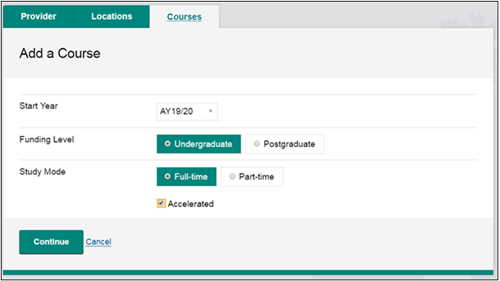
Validation on the Add Course screen ensures that the academic year you select determines what course types you can create for that year in line with policy.
Courses created in a previous academic year will automatically appear in any future academic year, ready to be saved. When you add a new course, the system will create a new SLC course code (or codes if there are several course variants). - Select Continue. This will take you to the Course Details screen. The Study Mode field here will show that you've chosen to create an accelerated degree.
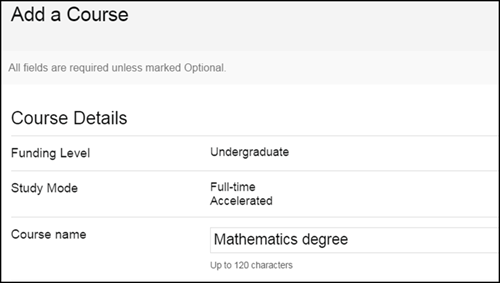
- Choose the appropriate option from the Qualification dropdown. An accelerated course can lead to one of 3 qualifications: Bachelor Degree, Bachelor Degree with Honours or Integrated Masters Degree.
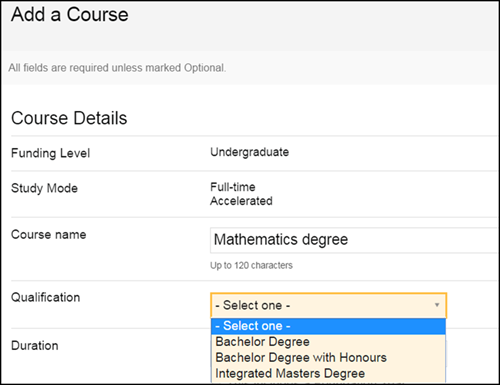
-
Select the course duration from the Duration dropdown. This has options from 1 to 7 years, according to the eligibility guidelines.
The accelerated course must be studied over the length of an equivalent standard-length course less one year. You do not need to provide a standard-length course in the same qualification and subject. In this context, an equivalent course is one that would lead to the same or equivalent academic award in the same or equivalent subject.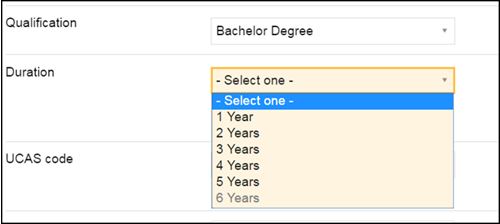
-
Add all the relevant course attributes as you would for your other courses. You cannot select the Medicine/Dentistry attribute on accelerated courses as special provisions already exist for these students. If you try to select this attribute, you'll get an error message and will not be able to save the course.
-
Enter the course fee. For an accelerated course, CMS will let you enter a fee of up to 1.2 times your provider fee cap (rounded up or down to the nearest whole £5). If you enter a fee higher than 1.2 times your fee cap, you'll get an error message and will not be able to save the course.
-
Enter your term dates. You should follow the term date guidance for full-time undergraduate courses. Long course loans are still available for accelerated courses, in addition to the standard rates of loan for living costs.
Shortened and compressed academic year
Where you have a compressed or shortened academic year, students will only be entitled to tuition and living cost support for the next year after a full 12-month period has passed.
A compressed academic year is not the same as an accelerated, compressed or fast-track course. These are defined separately in the Education (Student Support) Regulations.
If you're charging £6,000 for the first year of a full-time course starting in January, you can charge students a full £6,000. This applies whether they're taking this first year over the full academic year (January to December) or in a compressed or shortened mode (for example, January to August). However, you cannot receive a further tuition fee loan for the second year of that course until 1 January the following year.
Students starting full-time or part-time courses where the first year is compressed or shortened can apply for the same up front tuition fee loans as students completing a full academic year. However, they will not be able to access a second year of tuition fee or living costs support until after the end of the full academic year period. This is as defined by regulations.
For example, unless a student is transferring to a new course or has withdrawn from one course to begin another, their academic year start will remain the same throughout their studies.
If you enter term dates for a compressed or shortened academic year, you'll need to confirm this before you can save the course details. CMS will show a confirmation check box that says, 'This course includes a compressed year'.
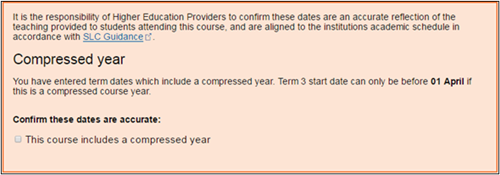
Entering term dates – undergraduate courses only
English, Scottish and Northern Irish-domiciled students
You should ensure that term dates in CMS reflect the term date advice in this guide. Do not enter term dates that overlap in the same academic year.
Example 1
A student begins a 2.5-year degree programme with a shortened first academic year.
The student’s study pattern is:
Year 1 – January to July
Year 2 – September to July
Year 3 – September to July
CMS must show their study pattern as:
Year 1 – January to December
Year 2 – January to December
Year 3 – January to July
Example 2
A student begins a shortened foundation year before progressing onto the chosen degree pathway.
The student’s study pattern is:
Year 1 – September to December
Year 2 – January to December
Year 3 – January to December
Year 4 – January to December
CMS must show their study pattern as:
Year 1 – September to July
Year 2 – September to July
Year 3 – September to July
Year 4 – September to December
If the final academic year is less than 15 weeks, you cannot receive more than 50% of the maximum fee cap in tuition fee loan. This would be:
- £4,625 for AY 2024/25 and prior
- £4,765 for AY 2025/26 onwards
This fee reflects the shortened academic year.
For full-time courses, you should space the term dates throughout the academic year. This guarantees students are paid at regular and timely intervals, while still respecting the liability period restrictions. It also ensures that the term lengths reflect the teaching provided to students, though we appreciate that this may not align to your true academic schedule.
Welsh-domiciled students
If a Welsh-domiciled student starts a compressed or shortened academic year, the Welsh Government lets them access the next year’s tuition and maintenance support from the point the next year of study begins.
Example
- you confirm the student’s attendance
- you're paid £2,000 fee loan or grant in February
- you confirm the student’s attendance
- you're paid £2,000 fee loan or grant in May
- you confirm the student’s attendance
- you're paid £4,000 fee loan or grant in October
Student Awards Agency Scotland funding exceptions for EU students
The Student Awards Agency Scotland (SAAS) has confirmed some funding exceptions for EU students who do not have settled or pre-settled status through the EU Settlement Scheme.
These limited exceptions mean some EU students, including Irish nationals, can still apply to them for a tuition fee loan up to the maximum approved fee limit.
As the number of exceptions is very limited, we've agreed with SAAS that these courses can be generic. You do not need to set up specific courses for each subject.
When you add the course to CMS, please use the naming conventions below.
Start year: AY 2024/25
Funding level: undergraduate
Study mode: full-time
Course Name: EU - Portability Undergraduate Degree
Qualification: select the relevant qualification from the dropdown
Duration: select the relevant duration from the dropdown
UCAS code: select the No UCAS code checkbox
HEP course codes: leave this field blank
Subject categories (HECoS): 101274 (do not enter any other code)
Course attributes: leave this field blank
Designation: only select Scotland
Fees: the maximum fee limit approved by SAAS
Term dates: enter the term dates for each intake
SQA courses
The Department for Education (DfE) has given some providers specific designation to offer courses delivered by the Scottish Qualifications Authority (SQA). If you have this, you should choose an Advanced Diploma or Advanced Certificate qualification for these courses.
You must use these qualifications for courses that previously had a qualification of Higher National Diploma (HND) or Higher National Certificate (HNC).
If you've listed these courses with HND or HNC qualification before, you must start phasing them out. You can use the Available course years function to do this. You should create new versions of the courses with the correct qualification for new students.
If you have not received confirmation of designation from DfE, you must not enter these courses on CMS as they're not eligible for funding.
Higher Technical Qualifications
From academic year 2023/24, Higher Technical Qualifications (HTQs) are eligible for student finance support.
These are level 4 or 5 qualifications approved by the Institute for Apprenticeships and Technical Education (IFATE).
An eligible course must be:
- IFATE approved
- level 4 or 5
- at least one academic year in duration
- provided by or in conjunction with an Office for Students-registered provider in England
- offered by an awarding body with degree awarding powers (or foundation degree awarding powers, where applicable)
You should mark courses that meet the eligibility criteria as HTQ courses on CMS.
Creating a new full-time HTQ course on CMS
To create an HTQ course, go to the Courses tab and select Add a course. Enter all the course details and select the Higher Technical Qualification attribute. Please note you can only add the attribute at the point of course creation and you cannot add it later.
You can do this from academic year 2023/24.
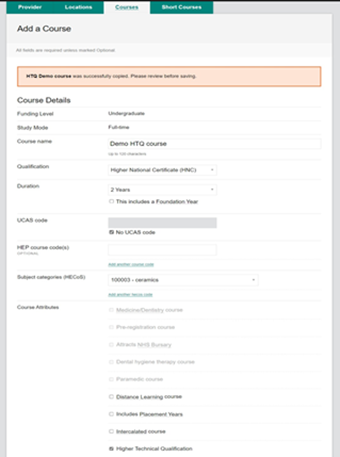
How to manage full-time HTQ courses that were previously designated for further education funding
You may have courses that received further education funding in the previous academic year and have now gained HTQ approval. For the upcoming academic year, you should select the applicable qualification on CMS. The system will then automatically apply the HTQ attribute. If it does not apply the HTQ attribute, you should check that you're using the correct qualification.
When you create the course, you must use the available course years option to ensure only new students can apply for higher education funding for it.
You should set it up as:
- year 1 – all students
- year 2 – no students
Returning students who received further education funding in the previous academic year must not apply for higher education funding. They should continue to follow their current funding arrangements.
You must only make HTQ courses that were previously designated for further education funding available for English-domiciled students. Make sure no other domiciles are selected when you enter the course details.
We'll check all courses with the HTQ attribute to make sure they match the approved HTQ list from the Department for Education.
How to manage full-time HTQ courses that were previously designated for higher education funding
You should not roll over your existing full-time courses that have gained HTQ approval and do not have the HTQ attribute attached. You should create new versions of these courses on CMS instead. Follow the Creating a new full-time HTQ course on CMS guidance and select the HTQ attribute.
Both new and returning students should apply to the new version of the course. You should set up the available course years option to allow for this
- year 1 – all students
- year 2 – all students or returners
If you roll over existing courses that do not have the HTQ attribute in error, you should set them to no students for the new academic year. Once you've done this, you should create a new version with the HTQ attribute.
Any HTQ course that previously attracted higher education funding can still attract it if the underlying qualification was already designated. You should make courses available for students domiciled in England and the devolved administrations.
We'll check all courses with the HTQ attribute to make sure they match the approved HTQ list from the Department for Education.
New OCN Level 5 Extended Diploma qualification – Northern Irish providers and students only
This is a new qualification for Northern Irish students from academic year 2023/24. The qualification is: OCN Level 5 Extended Diploma in Hair and Beauty Management.
This replaces the existing Pearson HND in Hair and Beauty Management. We've added a new OCN Level 5 Extended Diploma qualification option to CMS. You must select this option when you add the course.
You should only be using this qualification if:
- you're a Northern Irish provider
- you're using it for the designated OCN Level 5 Extended Diploma Hair and Beauty Management course
You must only add this course for Northern Irish students.
You should only add the course for new students from academic year 2023/24 onwards.
You must not use this qualification option on CMS for any other course.
Full-time undergraduate distance learning - Northern Ireland
Northern Irish students who are studying distance learning may be entitled to part-time funding.
To ensure students can be assessed for the correct funding you should set up the courses as part-time courses. As this is unique to Northern Ireland domiciled students you must ensure that only Northern Ireland is selected in the Designation section of the course. You can find further information on how to create part-time courses here.
Integrated Masters - Republic of Ireland only
When you set up an Integrated Masters course for Northern Irish students studying in the Republic of Ireland, the setup depends on the fees charged.
If you charge students a fee consistent with the Student Contribution Charge, their course must be set up as a full-time undergraduate course – selecting the 'Integrated Masters' qualification.
If you charge your students a Postgraduate Tuition Fee higher than the Student Contribution Charge for their final year, you should set up their course as two separate courses:
- the initial undergraduate years as a full-time undergraduate course
- the master’s year as a postgraduate course
This is to make sure that the correct support is available.